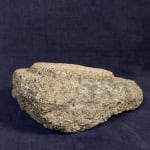







artisan's name unknown
Stepping Stone (Fumiwake-ishi) , 18th century (Mid Edo Period)
Stone
7” X 16” X 14”
Further images
-
(View a larger image of thumbnail 1
)

-
(View a larger image of thumbnail 2
)

-
(View a larger image of thumbnail 3
)

-
(View a larger image of thumbnail 4
)

-
(View a larger image of thumbnail 5
)

-
(View a larger image of thumbnail 6
)

-
(View a larger image of thumbnail 7
)

-
(View a larger image of thumbnail 8
)

It is a stone from a tea garden in Kyoto, carved about 300 years ago. The stone is known as a Fumiwake Ishi (踏分け石)—a stepping stone at the crossroads. In...
It is a stone from a tea garden in Kyoto, carved about 300 years ago. The stone is known as a Fumiwake Ishi (踏分け石)—a stepping stone at the crossroads.
In Japanese tea gardens, oblong or square stepping stones direct one’s footsteps in a particular direction. Then, when you approach the elevated, round shape of the Fumiwake stone, it tells you the passage will divide. The Fumiwake Ishi stone stands at the fork.
At some point in everyone’s life, they encounter a crossroad where life-changing decisions happen. This stone is a serene and comforting companion that evokes the emotions experienced when faced with such choices.
In Japanese tea gardens, oblong or square stepping stones direct one’s footsteps in a particular direction. Then, when you approach the elevated, round shape of the Fumiwake stone, it tells you the passage will divide. The Fumiwake Ishi stone stands at the fork.
At some point in everyone’s life, they encounter a crossroad where life-changing decisions happen. This stone is a serene and comforting companion that evokes the emotions experienced when faced with such choices.